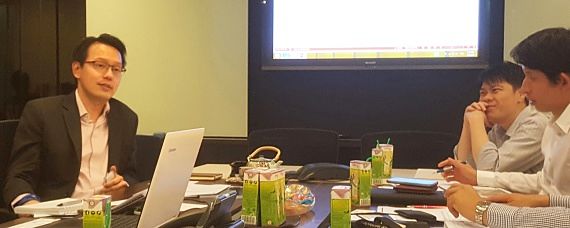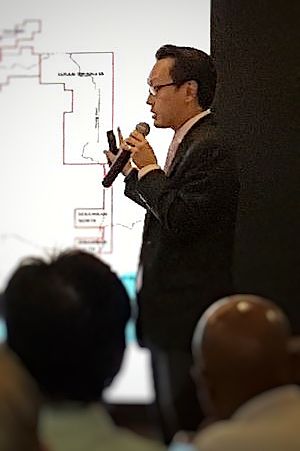 Mark Zhou (left), head of investments, Golden Energy & Resources, at FY16 results briefing. Photo by Leong Chan Teik Golden Energy & Resources (GEAR) resumed trading on SGX just three months ago (12 Dec 2016) after completing a compliance placement of its shares following its April 2015 reverse takeover of United Fibre System. Mark Zhou (left), head of investments, Golden Energy & Resources, at FY16 results briefing. Photo by Leong Chan Teik Golden Energy & Resources (GEAR) resumed trading on SGX just three months ago (12 Dec 2016) after completing a compliance placement of its shares following its April 2015 reverse takeover of United Fibre System.
Taking advantage of higher coal prices, GEAR increased its production volume. Thus, its 2016 full-year result was an excellent profit after tax and minority interests of US$21.8m, reversing a US$9 million loss in 2015. And this was above KGI Securities' forecast of US$16.9 million. So where does KGI see GEAR's profit in 2017? It is a whopping US$95.8 million. |
||||
As described previously (GOLDEN ENERGY & RESOURCES: 3 things to focus on), GEAR's fortune is closely linked to the price of coal and the volume of coal it produces.
The former is not within its control (and is its key risk factor) but the latter is.
GEAR targets to raise its production by 47% this year -- ie, 14 million tonnes versus 9.5 million last year.
Back-of-the-envelope estimates suggest a gross profit of US$280 million, assuming an average selling price of US$40 per tonne (ie 14 million tonnes x US$20).
The estimated US$20 gross profit per tonne is the difference between the price of coal of the grade that GEAR produces and its cash cost of production.
The selling price has stabilised at around US$45 a tonne in Feb this year (Jan 2017: US$46 a tonne). Prices are expected to be range-bound in the near term.
GEAR's cost of production is relatively low compared to other miners at less than US$20 a tonne owing to several factors, including:
1) GEAR's key concession, BIB, is just 25 km on average to the sea, unlike some mining peers which depend on rivers and public ports to transport coal to ships at sea. At GEAR's port, conveyor belts extend 800 metres to the Java Sea, which enable direct loading onto large barges.
|
Aside from its coal mine concessions, GEAR owns a forestry concession that spans 265,095 hectares. Mark Zhou, head of investments at GEAR, points out the plus points: |
2) About 20,000 hectares out of 24,000 hectares of BIB's concession lie below a forestry concession owned by United Fiber System, the company that GEAR did a RTO of.
Thus -- and here's something uncommon among coal miners in Indonesia -- there is "large savings" on costs that are otherwise payable to a forestry concession owner, says GEAR.
3) Lower stripping ratio -- which is the tonnage of overburden removed to extract the same tonnage of coal -- compared to other domestic and international coal producers.
To a question on dividends, Mark Zhou replied that GEAR did not pay a dividend for FY2016 owing to accumulated losses incurred mainly prior to its reverse takeover.
The accumulated losses have dropped from US$41 million at end-2015 to US$18.7 million at end-2016.
  Domestic demand from power plants will be a game-changer with demand estimated to rise to 360 million tonnes a year by 2024. Domestic demand from power plants will be a game-changer with demand estimated to rise to 360 million tonnes a year by 2024. To put it in perspective, Indonesia currently produces 400 million tonnes a year and not all of it is suitable for power plants. What differentiates GEAR from other producers is that our large reserves are able to support both domestic power plants over their life of mine as well as export demand, and we have the flexibility to swing either way. -- Mark Zhou, head of investments, GEAR (NextInsight file photo) |
For the Powerpoint presentation materials, click here.






